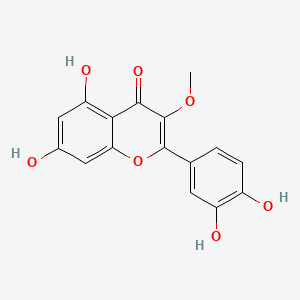| MeSH term | MeSH ID | Detail |
|---|---|---|
| Cell Transformation, Neoplastic | D002471 | 126 associated lipids |
3-O-Methylquercetin
3-O-Methylquercetin is a lipid of Polyketides (PK) class. 3-o-methylquercetin is associated with abnormalities such as Colitis, Hemorrhagic diarrhea and Diabetes. The involved functions are known as Inflammation, Trans-Activation (Genetics), Signal Transduction, Binding, Competitive and Antiinflammatory Effect. 3-o-methylquercetin often locates in Mucous Membrane. The associated genes with 3-O-Methylquercetin are IL2 gene, Human gene and ABCB1 gene. The related experimental models are Streptozotocin Diabetes.
Cross Reference
Introduction
To understand associated biological information of 3-O-Methylquercetin, we collected biological information of abnormalities, associated pathways, cellular/molecular locations, biological functions, related genes/proteins, lipids and common seen animal/experimental models with organized paragraphs from literatures.
What diseases are associated with 3-O-Methylquercetin?
3-O-Methylquercetin is suspected in Colitis, Hemorrhagic diarrhea, Diabetes and other diseases in descending order of the highest number of associated sentences.
Related references are mostly published in these journals:
| Disease | Cross reference | Weighted score | Related literature |
|---|
Possible diseases from mapped MeSH terms on references
We collected disease MeSH terms mapped to the references associated with 3-O-Methylquercetin
PubChem Associated disorders and diseases
What pathways are associated with 3-O-Methylquercetin
There are no associated biomedical information in the current reference collection.
PubChem Biomolecular Interactions and Pathways
Link to PubChem Biomolecular Interactions and PathwaysWhat cellular locations are associated with 3-O-Methylquercetin?
Visualization in cellular structure
Associated locations are in red color. Not associated locations are in black.
Related references are published most in these journals:
| Location | Cross reference | Weighted score | Related literatures |
|---|
What functions are associated with 3-O-Methylquercetin?
Related references are published most in these journals:
| Function | Cross reference | Weighted score | Related literatures |
|---|
What lipids are associated with 3-O-Methylquercetin?
There are no associated biomedical information in the current reference collection.
What genes are associated with 3-O-Methylquercetin?
Related references are published most in these journals:
| Gene | Cross reference | Weighted score | Related literatures |
|---|
What common seen animal models are associated with 3-O-Methylquercetin?
Streptozotocin Diabetes
Streptozotocin Diabetes are used in the study 'Plant flavonol isorhamnetin attenuates chemically induced inflammatory bowel disease via a PXR-dependent pathway.' (Dou W et al., 2014).
Related references are published most in these journals:
| Model | Cross reference | Weighted score | Related literatures |
|---|
NCBI Entrez Crosslinks
All references with 3-O-Methylquercetin
Download all related citations| Authors | Title | Published | Journal | PubMed Link |
|---|---|---|---|---|
| Fatima T et al. | Metabolite profiling and expression analysis of flavonoid, vitamin C and tocopherol biosynthesis genes in the antioxidant-rich sea buckthorn (Hippophae rhamnoides L.). | 2015 | Phytochemistry | pmid:26318327 |
| Vitalini S et al. | Primula spectabilis Tratt. aerial parts: morphology, volatile compounds and flavonoids. | 2011 | Phytochemistry | pmid:21612805 |
| Suzuki H et al. | Metabolic profiling of flavonoids in Lotus japonicus using liquid chromatography Fourier transform ion cyclotron resonance mass spectrometry. | 2008 | Phytochemistry | pmid:17669449 |
| Ma YC et al. | An effective identification and quantification method for Ginkgo biloba flavonol glycosides with targeted evaluation of adulterated products. | 2016 | Phytomedicine | pmid:27002408 |
| Zou L et al. | Effects of intrinsic fluorescence and quenching on fluorescence-based screening of natural products. | 2002 | Phytomedicine | pmid:12046870 |
| Kim B et al. | Eruca sativa and its flavonoid components, quercetin and isorhamnetin, improve skin barrier function by activation of peroxisome proliferator-activated receptor (PPAR)-α and suppression of inflammatory cytokines. | 2014 | Phytother Res | pmid:24610745 |
| Lee SH et al. | Persicaria hydropiper (L.) spach and its flavonoid components, isoquercitrin and isorhamnetin, activate the Wnt/β-catenin pathway and inhibit adipocyte differentiation of 3T3-L1 cells. | 2011 | Phytother Res | pmid:21413092 |
| Smolarz HD et al. | Influence of ethyl acetate extract and quercetin-3-methyl ether from Polygonum amphibium on activation lymphocytes from peripheral blood of healthy donor in vitro. | 2003 | Phytother Res | pmid:12916071 |
| Pengfei L et al. | Antioxidant properties of isolated isorhamnetin from the sea buckthorn marc. | 2009 | Plant Foods Hum Nutr | pmid:19444611 |
| Antunes-Ricardo M et al. | Induction of apoptosis in colon cancer cells treated with isorhamnetin glycosides from Opuntia ficus-indica pads. | 2014 | Plant Foods Hum Nutr | pmid:25186940 |
